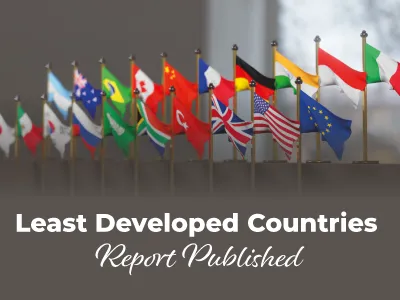
Crisis Resilient Development Finance
According to UNCTAD's Least Developed Countries (LDC) Report 2023, the critical fiscal challenges facing 46 of the world's most vulnerable countries must be urgently addressed.
Multiple global crises, the climate emergency, rising debt burdens, dependence on commodities, and declining foreign investment in Loss and Damage Funds (LDFs) are straining their finances, jeopardizing their progress toward the Sustainable Development Goals (SDGs), including a low-carbon transition.
The Lost and Damage Fund (LDF), which will debut at the 28th UN Climate Change Conference (COP28), could be a game changer if LDCs are among the primary beneficiaries, sufficient resources are available, and payments are made quickly. However, the financing needs in these countries may go far beyond climate issues to encompass broader economic and social problems. Against this backdrop, the report urgently calls for a lasting, multilateral solution to the debt crisis in these countries and to mobilize the development and climate finance they need. It also highlights the critical role that local actors, especially central banks, can play in mobilizing national resources and channeling financial flows towards a green structural transformation in these countries.
Closing Financing Gaps
Expanding the Financial Area of the Loss and Damage Fund
The shrinking fiscal space of the Loss and Damage Fund limits its ability to implement development policies. This forces them to choose between paying off external debt and investing in health, climate, and education action. Fiscal space is a government's capacity to absorb declines in public revenues. In this context, fiscal space has been squeezed by global crises such as the COVID-19 pandemic, the climate emergency, and the war in Ukraine, which has triggered food and energy price hikes worldwide.
To soften the blow, LDCs have gone into debt to strengthen social safety nets and economic support, as another 15 million people in developing countries have fallen into extreme poverty since the pandemic. This led to more spending. It, therefore, demonstrated how important it is for the international community to take urgent and bold steps to ensure that LDCs have better access to affordable and long-term international financing, especially from public sources. Especially with external financial support, LDCs' development of internal resource mobilization will be very effective in reducing tax rates. For example, the median tax/GDP ratio was 11.6% in 2020, compared to 16.3% in other developing countries and 23.2% in developed countries.
Creating the Global Financial System
Working for LDCs
The international financial structure needs to be more appropriate, specifically designed, and targeted financial mechanisms for underdeveloped countries. In addition, post-COVID-19 reforms have remained below expectations. Additionally, promises and commitments regarding international climate finance and official development assistance have yet to be fulfilled. This causes the external financing available to LDCs to be expensive, insufficient, and accompanied by economic and political problems. As needs increase amid ongoing global crises, UNCTAD calculations show that LDCs bear the highest per capita cost to achieve the Sustainable Development Goals relative to countries' economies. The report underlines the limited influence of LDCs on development financing decisions affecting them, regardless of whether international resources are bilateral or multilateral, public or private. For example, while LDCs represent only 4% of the World Bank's voting rights, they received less than 2.5% of the International Monetary Fund's special drawing rights exported in 2021.
The report emphasizes that three critical dimensions of effective climate and development finance for LDCs need to be addressed: Quantity, availability, and access. In this context, all funds must be available on the necessary scale and provided through low-costmeans.
 Back
Back







